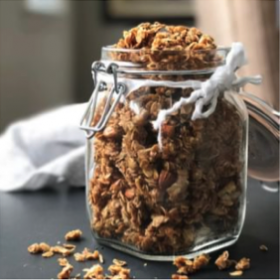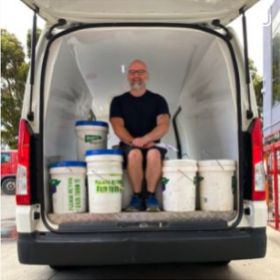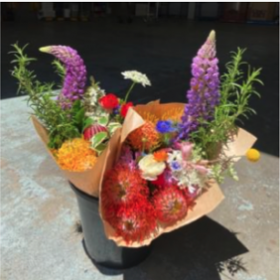Ingredients
Quinces – as many as you have or can fit into your biggest pot or slow cooker, whole and covered with water
Sugar – Roughly 3/4 of the weight of the quinces you are using eg. 2kg fruit will need at least 1.5kg sugar
Optional – place a vanilla pod and its seeds (scraped out with a knife) into the simmering pot
Optional – 1tsp Agar agar per kilo of quince (if you’re worried about your paste not coming to the firmness you desire, you can add this before the chilling process at the end and it will help it firm up!)
Summary
Everyone wants quince paste on their cheeseboard. With time, heat and sugar, you can transform autumn’s strange offering into a divine condiment and enjoy it with the satisfaction that comes from making something you might otherwise have bought. It’s a long, slightly messy but easy process, so if time is on your side try making a batch – it might be the alternative passata-making tradition for you.
Quince Paste
Here’s a synopsis of the process: weigh the quinces, rub off any fur on the skin and cook the quinces whole (takes a few hours), purée them, simmer and reduce with sugar (another few hours), pour the paste into a tray and leave for a day to set. Quince paste!
Cook the quince: So, the easiest way to cook up the quinces is probably with a slow cooker. Leave them whole, cover with water and cook overnight on low. Without such an appliance, just poach them on the stove for a couple of hours. Slow cooking the quinces whole will help to maximise the pectin in the purée, which will set the paste. Pectin levels also reduce as the fruits ripen and become more yellow, so choose your greenest fruit for this.
Puree the quince: Now that they’re cooked, you can puree them in a blender or food processor – leave the core and peel on for extra pectin.
Reduce the quince: Gently heat the puree in your most generous pot. Add the sugar – roughly 3/4 of the weight of the original quinces, or thereabouts, and simmer on the lowest hob (or slow cooker) for 3-5 hours – lid off. Let it reduce as it bubbles away, becoming thicker and gloriously red. You’ll need to stir it occasionally, and skim off any scum that appears at the surface. Just be careful as it can spit a bit, keep it on very low.
At some point, after several hours, it’ll be past the jam stage and the whole hot purée will be thick and start coming away from the sides. Though a runnier version will still taste fantastic as a jam or syrup over ice cream, you can’t beat those nice gift-giving slabs so keep going if you can – until it becomes as thick as you can manage. If you’re worried it’ll never get thick enough, add in the tsp of agar agar and mix thoroughly to combine, it’ll help firm it up as it cools.
Line a shallow tray with baking paper, and pour the hot mess of it into the tray. Leave it for a day, then cut into sections once it has set. If you’re not convinced it will actually set firmly, pour it into small gift-able jars.
Eat liberally with a good manchego or stinky blue cheese, and perhaps a nice glass of red!
Hints and Tips
*we have made this several times removing skins and cores however, leaving them on increases the pectin levels so if you’d prefer to a firmer paste leave them in!



What to say, but it’s perfect, cheese and jam!!
but for me the best is sheep cheese and jam of figs !!
but this is so delicious
Thanks for the recipe. I pushed most of the mix through a sieve for a smoother pate. A question though- mine isn’t red in colour, it actually looks more like caramel colour. What’s gone wrong?
Our pleasure Jane! Hope it’s deliciously enjoyable and well done, the smoother texture is next level. Perhaps the more caramel colour is due to a different variety of quince, we’re not sure. If you find out from a quince paste expert let us know!
Hi—the longer you cook the fruit, the deeper red it gets! It has to do with forming anthocyanins which is a natural pigment (tannin)!
After I use a food mill I put it back into the sauce pan and on the heat to deepen the color.
Ooo we love this tip – the colour is SO beautiful!
Just made this today, my Mum had soo many Quinces so I bit tbe bullet and gave it a shot, this worked a treat! Though its on my ceiling lmao!!
Also I used 2kgs is made ALOT can I freeze the paste? How long does it last cut up?
Hey Alison, hard to say but quince paste has been known to keep in the back the fridge FOR A VERY LONG TIME. Wrap well in segments, you might still be enjoying it before next year’s batch takes over.
When cooking the purée in a slow cooker do you put the glass lid on or leave it off? Also after you put it into the shallow try do you need to refrigerate or leave out at room temp?
Sorry for the late reply Celia! Lid off when you’re simmering as you want some of the water to evaporate and the paste to thicken. You can put it straight in the fridge once in the shallow tray. You must be making quince paste in the northern hemisphere somewhere – it’s wonderful to think of our recipes travelling so far!